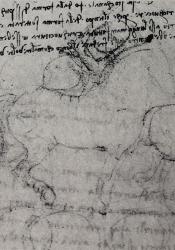Da Vinci Completes Sforza Monument Clay Model
Da Vinci's initial works contained too abstract ideas and could not be cast into bronze with a single pour, retendering them incompletable. In his first two main designs, he had a horse rearing up over a fallen foe (Hanson, 2012). Although the fallen foe aided with the stability of the horse, it prohibited a single pour casting. His third design significantly differed from the other two, as it did not contain the fallen foe and was in a frozen trot with two suspended legs (Hanson, 2012). By 1490, Da Vinci began more intense work on the monument and completed a 24-foot clay model of a more detailed version of his third design by 1493, which sat in the Cortile Vecchio of the Castello at Milan (Grierson, 1959). Before Da Vinci’s attempt with his clay horse, no one had created such an equestrian statue with two suspended legs. One suspended leg, as in the Colleoni monument, poses a great challenge with stabilizing the center of gravity; having two suspended legs further heightens this challenge.
To account for the instability of the statue with two airborne legs and to protect it against several environmental factors, Da Vinci had an intricate structure of the horse. He designed the inside of the horse to have a steel “skeletal structure,” essentially trusses within the horse, and thick metal walls (Ahl, 1995, p. 136). Even though such framing led to other problems, it miraculously maintains the structure of the horse. Such a comprehensive design stands as a feat for the 1400s and 1500s.
Ahl, D. (1995). Leonardo da Vinci's Sforza monument horse: The art and the engineering. Bethlehem [Pa.]: London; Cranbury, NJ: Lehigh University Press; Associated University Presses.
Grierson, P. (1959). ERCOLE D'ESTE AND LEONARDO DA VINCI'S EQUESTRIAN STATUE OF FRANCESCO SFORZA. Italian Studies, 14(1), 40-48.
Hanson, E. J. (2012). Inventing the sculptor: Leonardo da Vinci and the persistence of myth (Doctoral dissertation, Washington University) [Abstract]. All Theses and Dissertations (ETDs),765. doi: https://doi.org/10.7936/K7PN93MQ

